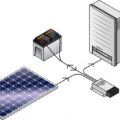Understanding Solar Lights and How They Work
Solar lights are a popular outdoor lighting solution, known for their efficiency and eco-friendly nature. But can they work effectively indoors? To answer this question, it’s important to understand the mechanics behind how solar lights function. Solar lights operate by absorbing sunlight during the day and storing it as energy in a rechargeable battery. When the sun sets, a photoreceptor detects the lack of light and signals the LED light to turn on, using the stored energy. So, theoretically, solar lights can work indoors as long as they are exposed to a sufficient amount of light to charge the battery.

The Role of Photovoltaic Cells in Solar Lights
The key to understanding how solar lights work, both outdoors and indoors, is to understand the role of photovoltaic cells. These cells are responsible for converting sunlight into electricity. They are made up of semiconductor materials, usually silicon, that absorb photons from the sunlight, generating electricity. The electricity is then stored in a battery for later use. For solar lights to work indoors, they need to be exposed to a light source that can generate enough photons to stimulate the photovoltaic cells. However, the efficiency of this process can vary significantly based on the intensity and quality of the light source.
The Importance of Direct Sunlight for Solar Lights
Solar lights rely heavily on direct sunlight for optimal performance. The energy they absorb from the sun is directly proportional to the intensity and duration of sunlight they receive. While it is possible for solar lights to work indoors, their efficiency may be compromised due to the lack of direct sunlight. Indoor lighting, while capable of stimulating the photovoltaic cells, is often not as intense or consistent as direct sunlight. This can lead to a reduced output from the solar lights.
Can Solar Lights Work with Indoor Lighting?
Despite the challenges, solar lights can indeed work with indoor lighting. However, the functionality of this arrangement largely depends on the type of indoor lighting used. Not all indoor lights can provide the necessary light spectrum for the photovoltaic cells to function effectively. For instance, incandescent bulbs may not provide sufficient light, whereas LED or fluorescent lights may be more effective. It’s also important to ensure that the solar lights are positioned close to the light source for maximum absorption.
Exploring the Efficiency of Solar Lights Indoors
While it is possible for solar lights to work indoors, their efficiency is a point of consideration. The output of indoor solar lights is often significantly lower than their outdoor counterparts due to the lower intensity of indoor lighting. However, with the right setup and lighting conditions, they can still provide a reasonable amount of light. This makes them a viable option for low-light areas in the home or for use during power outages.
Practical Applications of Indoor Solar Lights
Indoor solar lights can be quite practical in certain situations. They can be used in areas of the home that receive a good amount of sunlight, such as windowsills or sunrooms. They can also be used as a backup lighting source during power outages. In addition, indoor solar lights can be a great way to reduce energy consumption and contribute to a more sustainable lifestyle.

Challenges of Using Solar Lights Indoors
While the use of solar lights indoors presents several advantages, it also comes with its own set of challenges. The biggest challenge is ensuring that the solar lights receive enough light to charge effectively. This can be difficult in homes that do not receive a lot of natural light or during periods of the year when daylight hours are shorter. Additionally, the quality of indoor light may not be sufficient to fully charge the solar lights, leading to reduced performance.
Tips to Improve the Performance of Indoor Solar Lights
To optimize the performance of indoor solar lights, it’s important to position them in areas that receive the most light. If using artificial light, ensure that the light source is close to the solar panel and that the light is of the right spectrum. Regularly cleaning the solar panel can also improve light absorption. Finally, choosing solar lights with high-quality photovoltaic cells and batteries can significantly enhance their efficiency and lifespan.
Innovative Ways to Use Solar Lights Inside the Home
There are many innovative ways to use solar lights indoors. They can be used as decorative elements, adding a unique touch to your home decor. Solar string lights, for instance, can be draped around a window or across a wall. Solar lanterns can be used as a centerpiece on a dining table or hung in a corner for a cozy ambiance. With a bit of creativity, the possibilities are endless.
The Future of Solar Lights in Indoor Spaces
Looking ahead, the use of solar lights in indoor spaces presents exciting possibilities. Advances in solar technology are likely to lead to more efficient and versatile indoor solar lighting solutions. As our understanding of photovoltaic cells improves and as the drive towards sustainable living continues to grow, we can expect to see a greater adoption of indoor solar lights in the future.












Leave a Reply